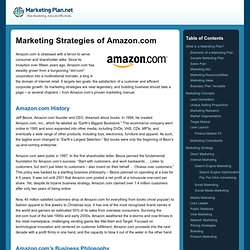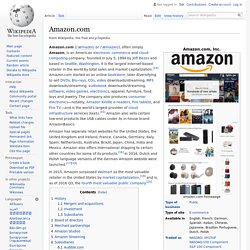

Amazon.com-Logo.svg - Wikipedia, the free encyclopedia. Where Is Your White Space? - Mark W. Johnson - The Conversation. By Mark W.

Johnson | 2:30 PM February 12, 2010 “We see local as the big white space.” That’s America Online (AOL) CEO Tim Armstrong recently explaining to a group of investors how AOL’s “digitizing towns” initiative (to offer one-stop website-management services to municipalities all across the U.S.) would position the company to compete against the likes of Google, Yelp, and CitySearch as the company looks for a clear path away from the disappearing dial-up subscription market. In this context, white space basically means “a place where a company might have room to maneuver in a crowded playing field.” For all its ambiguity, though, white space is undoubtedly a metaphor about opportunity; different thinkers define it differently because they take varying approaches to capturing opportunity. These might be opportunities to bring your own innovations to market — Apple’s iPod is a great example and so were the mouse and laser printer (albeit ones their inventor, Xerox, failed to develop).
Marketing Strategies of Amazon.com. Amazon.com is obsessed with a fervor to serve consumer and shareholder alike.

Since its inception over fifteen years ago, Amazon.com has steadily grown from a burgeoning “dot-com” corporation into a multinational monster, a king in the domain of internet retail. It targets two goals: the satisfaction of a customer and efficient corporate growth. Its marketing strategies are near-legendary, and budding business should take a page – or several chapters – from Amazon.com’s proven marketing manual. Amazon.com History Jeff Bezos, Amazon.com founder and CEO, dreamed about books. Amazon.com went public in 1997. Now, 45 million satisfied customers shop at Amazon.com for everything from books (most popular) to fashion apparel to fine jewelry to Christmas toys.
Amazon's Smart Innovation Strategy. Building a great business and operating it well no longer guarantees you'll be around in 100 years, or even 20.

In 1958, the average length of time a company remained on the S&P 500 was 57 years; by 1983, it had dropped to 30 years; in 2008, it was just 18. Shorter business life cycles require a new sort of management discipline capable of leading an organization through an ongoing process of transformation and renewal. To thrive in today's marketplace, to be built to last, every business now must be built to transform. Consider Amazon (AMZN), which emerged from the dot-com bubble one of the few winners and continued to blaze a trail of impressive growth (from about $4 billion in 2002 to nearly $20 billion in 2008).
One of the most unexamine facets of Amazon's high-profile success is its unabashed embrace of transformational growth in its white space. Then Amazon did it yet again, identifying a new area of potential growth by finding another new customer—the IT community. Amazon.com. Amazon has separate retail websites for the United States, the United Kingdom and Ireland, France, Canada, Germany, Italy, Spain, Netherlands, Australia, Brazil, Japan, China, India and Mexico.

Amazon also offers international shipping to certain other countries for some of its products.[16] In 2016, Dutch and Polish language versions of the German Amazon website were launched.[17][18] In 2015, Amazon surpassed Walmart as the most valuable retailer in the United States by market capitalization,[19] and is, as of 2016 Q3, the fourth most valuable public company.[20] History[edit] The company was founded in 1994, spurred by what Amazon founder Jeff Bezos called his "regret minimization framework," which described his efforts to fend off any regrets for not participating sooner in the Internet business boom during that time.[21] In 1994, Bezos left his employment as vice-president of D.
E. Mergers and acquisitions[edit] Investment[edit] Subsidiaries[edit] Board of directors[edit] Goodreads[edit] A9.com. A9.com is a subsidiary of Amazon.com based in Palo Alto, California that develops search and advertising technology.

A9 has teams in Palo Alto, Bangalore, Beijing, Dublin, Iasi, and Tokyo. A9 has development efforts in five areas: Product searchCloud searchVisual searchAdvertising technologyCommunity question answering History[edit] A9 was created by Amazon.com in 2003 as an independent company aimed at producing technology advances in Search and Advertising. One purpose of A9.com was to leverage clever algorithms, and the name was chosen as a numeronym to represent ALGORITHMS (i.e.